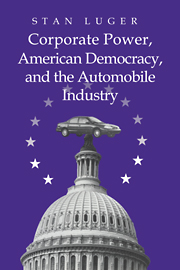Book contents
- Frontmatter
- Contents
- Acknowledgments
- Introduction
- 1 Studying Power in America
- 2 The Structure of the Auto Industry
- 3 Corporate Political Hegemony and Its Decline: 1916–1966
- 4 The Politics of Compromise: 1967–1978
- 5 The Resurgence of Corporate Power: 1979–1981
- 6 The Triumph of Corporate Power: Regulatory Policy, 1981–1988
- 7 The Triumph of Corporate Power: Trade Policy, 1981–1985
- 8 Interregnum: 1989–1996
- Conclusion: Corporate Power and American Democracy
- Index
5 - The Resurgence of Corporate Power: 1979–1981
Published online by Cambridge University Press: 08 October 2009
- Frontmatter
- Contents
- Acknowledgments
- Introduction
- 1 Studying Power in America
- 2 The Structure of the Auto Industry
- 3 Corporate Political Hegemony and Its Decline: 1916–1966
- 4 The Politics of Compromise: 1967–1978
- 5 The Resurgence of Corporate Power: 1979–1981
- 6 The Triumph of Corporate Power: Regulatory Policy, 1981–1988
- 7 The Triumph of Corporate Power: Trade Policy, 1981–1985
- 8 Interregnum: 1989–1996
- Conclusion: Corporate Power and American Democracy
- Index
Summary
While the auto industry had its political ups and downs during the 1970s, the oil shock of 1979 gave it a jolt. For the second time in six years, oil supplies were scarce and gas prices surged. Inflation rose to over 13 percent for 1979. Making matters worse, in 1980 unemployment rose to over 7 percent, yet the inflation rate remained largely the same. As the nation experienced a recession in 1980, there was an increased demand for small cars and foreign imports, each of which cut into Detroit's longstanding practice of selling large cars for large profits. Chrysler was hardest hit and teetered on the edge of bankruptcy.
The auto industry's problems only increased in the years that followed when the nation sunk into yet another recession in 1981 and 1982, one that set a new post–World War II high for unemployment. Given the industry's central importance to the nation's economy, its financial problems had national repercussions. With concerns over the economy mounting, government officials became increasingly vulnerable to corporate demands for policy changes. Instead of the bargaining and compromises that had characterized the prior decade or so, Detroit's executives gained the leverage to make government policy serve their interests. Government policy, which had previously prodded industry officials to make cars safer, more efficient, and less polluting, was now subordinated to the goal of economic recovery.
The Chrysler bailout was the first initiative in a new pattern of industry–government relations. When the pain of losses spread to the other automakers, President Carter extended government aid to the entire industry.
- Type
- Chapter
- Information
- Publisher: Cambridge University PressPrint publication year: 1999



